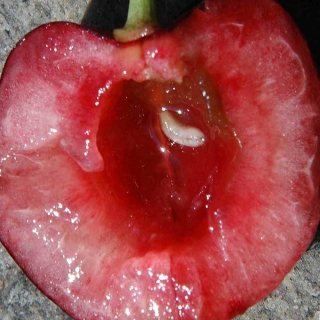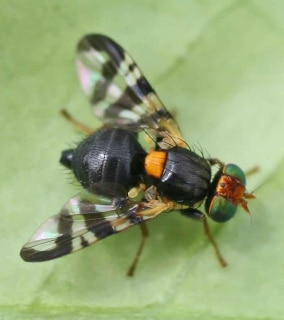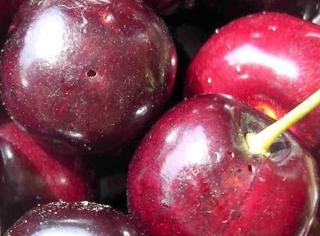

The bug often called “cherry fruit fly” is a tiny fly that lays eggs on ripening cherries. It’s also called the “cherry maggot“.
Generally, this happens end of May or beginning of June, and can last until July.
Refer to our guidance on how to effectively fight against cherry flies, and you’ll spare yourself the disappointment of seeing your cherry harvest ruined.
 From under the tree, it’s quite difficult to know whether the cherry fly is active or not. You’ll have to check on the cherries up close as soon as they start forming. Picking an infected one makes it easier to identify the pest.
From under the tree, it’s quite difficult to know whether the cherry fly is active or not. You’ll have to check on the cherries up close as soon as they start forming. Picking an infected one makes it easier to identify the pest.
Sometimes, you only discover this little white maggot when you already took a bite from the cherry! Eww!
Late-bearing cultivars are often harder hit than cultivars with early fruit fruit formation.
 It’s a small fly that belongs to the Rhagoletis family. There are a number of variations that look very similar:
It’s a small fly that belongs to the Rhagoletis family. There are a number of variations that look very similar:
These all are about a quarter-inch (4 mm) in size and are hard to see on the trees. They hover in flight as they inspect cherries to lay their eggs in. The maggots start off tiny and nibble around the pit until they’re about 1/4th inch (4 mm) long.
Here’s a video that shows the cherry fruit fly
 Once maggots are in a fruit, they ruin it. The only way to deal with it is to prevent their coming. Here are different ways to avoid or trap them:
Once maggots are in a fruit, they ruin it. The only way to deal with it is to prevent their coming. Here are different ways to avoid or trap them:
→ See also:
Start harvesting your cherries as soon as the first ones are ripening. Since the cherry fly usually lays eggs in soft, ripe cherries, you’ll be depriving it of potential nesting spots, while ensuring you at least get some fruits for yourself!
While picking, immediately eliminate cherries that show signs of fruit rot, and spray your hands with alcohol or disinfectant to keep the disease from spreading.
since the cherry flies develop in the ground from fallen cherries. Isn’t there a way to kill them in the soil?